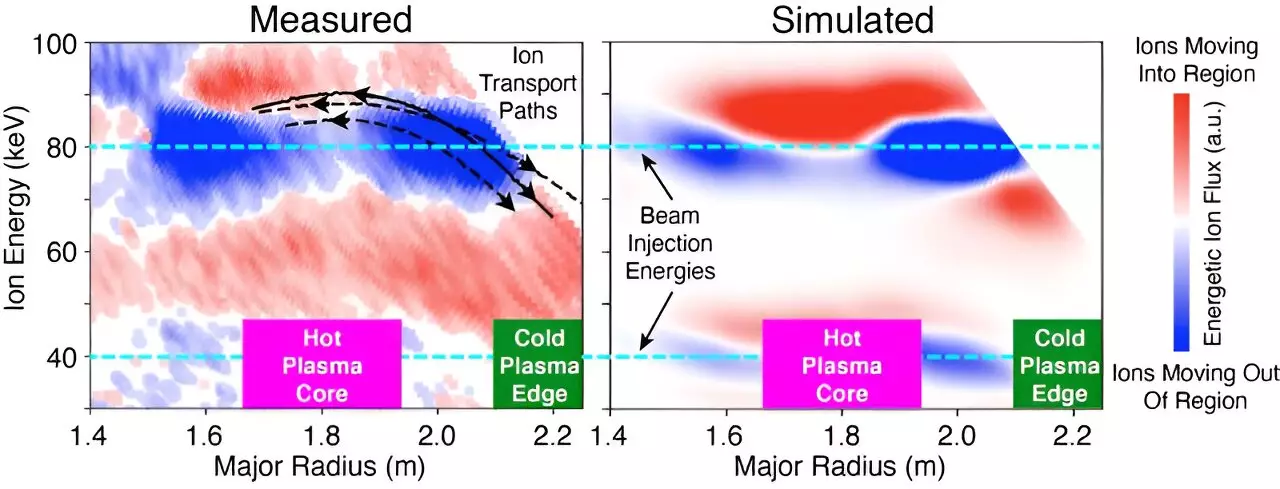The importance of maintaining confinement of fusion-produced energetic ions in a burning plasma cannot be overstated. However, there is a significant challenge in maintaining this confinement due to the presence of electromagnetic waves in fusion plasmas, which can push energetic ions out of the plasma. This interference reduces the heating of the plasma from fusion reaction products and ultimately ends the burning plasma state. Recent measurements conducted at the DIII-D National Fusion Facility have provided the scientific community with the first direct observations of energetic ions moving through space and energy in a tokamak. These measurements, combined with advanced computer models of electromagnetic waves and their interactions with energetic ions, have yielded valuable insights into the interplay between plasma waves and energetic ions in fusion plasmas.
Plasma physics and fusion research are evolving from experimental facilities towards demonstration power plant designs. To make this transition successful, accurate simulations and predictive tools are required to determine how power plant designs will perform. While most current facilities do not produce burning plasmas, researchers have gained a solid understanding of the underlying physics and are developing simulations to replicate observed experimental behavior. The recent research conducted at the DIII-D tokamak, which involved measuring the flow of energetic ions, was a crucial step towards improving models that account for the dynamics of wave-ion interactions. This enhanced understanding enables researchers to apply phase-space engineering, a process that allows them to design new fusion plasma scenarios based on the predicted interactions between waves and ions. Furthermore, the insights gained from this research could potentially contribute to improving the reliability of satellites, as interactions between waves and ions can also impair their functioning.
Researchers at the DIII-D National Fusion Facility utilized data obtained from a new diagnostic system called the Imaging Neutral Particle Analyzer (INPA) to observe the flow of energetic ions in a tokamak. The development of this system was a multi-year effort, involving conceptualization, design, and construction. The INPA provides researchers with the unprecedented capability to observe the behavior of energetic ions, which have been injected into the tokamak by neutral beams, as they interact with electromagnetic plasma waves and flow in terms of energy and position throughout the tokamak. The accuracy of first-principles models in describing the underlying physics was confirmed through simulations that replicated the observed behavior.
Improved understanding of wave-particle interactions is crucial for the design of fusion power plants and for gaining insights into the behavior of plasmas observed in outer space. The INPA measures the energy of neutral beam-injected energetic ions, which possess greater energies than the background plasma, over time and spatial position, from the hot plasma core to the cold plasma edge, where ions may be lost. Coupled with advanced high-performance computing simulations that model the spectrum of electromagnetic waves and their interactions with energetic ions, these experiments provide the most detailed understanding to date of the interplay between plasma waves and energetic ions in fusion plasmas. This deeper understanding of wave-particle interactions also enables researchers to apply phase-space engineering, an innovative process that leverages predicted ideal interactions between waves and ions to design new fusion plasma scenarios.
Similar wave-particle interactions occur in outer space, such as electromagnetic ion cyclotron (EMIC) waves causing electrons to flow through space and energy. In certain cases, the acceleration of electrons by these waves has resulted in malfunctions in satellites. Consequently, the improved understanding of wave-particle resonant interaction processes enabled by fusion plasma research has significant implications for simulating outer space plasma and potentially increasing the reliability of future satellite missions.
The research conducted at the DIII-D National Fusion Facility using the INPA has contributed valuable insights into the interplay between plasma waves and energetic ions in fusion plasmas. This research not only enhances our understanding of fusion power plant design but also has implications for outer space plasma simulations. By accurately modeling wave-particle interactions, researchers can develop more reliable predictions and designs, ultimately advancing the field of fusion research and space exploration.


Leave a Reply